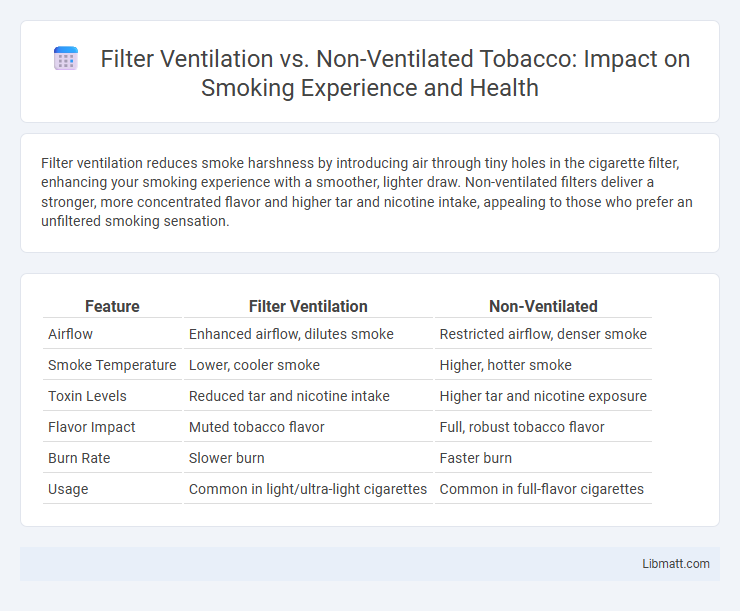Filter ventilation reduces smoke harshness by introducing air through tiny holes in the cigarette filter, enhancing your smoking experience with a smoother, lighter draw. Non-ventilated filters deliver a stronger, more concentrated flavor and higher tar and nicotine intake, appealing to those who prefer an unfiltered smoking sensation.
Table of Comparison
| Feature | Filter Ventilation | Non-Ventilated |
|---|---|---|
| Airflow | Enhanced airflow, dilutes smoke | Restricted airflow, denser smoke |
| Smoke Temperature | Lower, cooler smoke | Higher, hotter smoke |
| Toxin Levels | Reduced tar and nicotine intake | Higher tar and nicotine exposure |
| Flavor Impact | Muted tobacco flavor | Full, robust tobacco flavor |
| Burn Rate | Slower burn | Faster burn |
| Usage | Common in light/ultra-light cigarettes | Common in full-flavor cigarettes |
Introduction to Cigarette Filter Ventilation
Cigarette filter ventilation involves tiny perforations in the filter that dilute smoke with air, reducing tar and nicotine delivery. Non-ventilated filters lack these holes, resulting in a more concentrated and harsher smoke experience. Understanding these differences helps you make informed choices about smoking intensity and toxin intake.
What Is Non-Ventilated Filtration?
Non-ventilated filtration refers to a mask or respirator design that lacks external vents or exhalation valves, ensuring that all inhaled and exhaled air passes through the filter media. This type of filtration provides consistent protection by filtering both incoming and outgoing air, reducing the risk of contaminant escape and exposure. Your choice of non-ventilated filtration is ideal for environments requiring maximum containment and air purification without compromising safety.
Design Differences: Ventilated vs Non-Ventilated Filters
Ventilated filters feature strategically placed perforations around the filter area to allow controlled airflow, enhancing smoke dilution and reducing harshness. Non-ventilated filters lack these perforations, resulting in a denser filter that provides a firmer draw and retains more flavor intensity. The design differences affect airflow dynamics, filter cooling, and smoke delivery, making ventilated filters preferred for smoother smoking experiences while non-ventilated filters maintain stronger flavor profiles.
Impact on Smoke Composition and Delivery
Filter ventilation reduces the concentration of harmful chemicals in cigarette smoke by diluting it with air, which alters smoke composition and lowers tar and nicotine delivery. Non-ventilated cigarettes deliver smoke with higher levels of toxins and particulate matter, increasing exposure to harmful substances. Your choice between filter ventilation and non-ventilated options significantly impacts the intake of carcinogens and other toxic compounds during smoking.
Effects on Smoker Behavior
Filter ventilation and non-ventilated cigarettes impact smoker behavior differently by altering the perceived intensity and satisfaction of smoking. Ventilated filters dilute smoke with air, often leading smokers to inhale more deeply or increase puff frequency to achieve the desired nicotine effect. Your smoking patterns may change based on these differences, potentially affecting exposure to harmful substances despite lower tar and nicotine yields in machine tests.
Health Implications of Filter Ventilation
Filter ventilation in cigarettes reduces the intake of tar and harmful chemicals by diluting smoke with air, but it may encourage deeper inhalation, potentially increasing exposure to toxic substances. Non-ventilated cigarettes deliver a more concentrated smoke dose, leading to higher immediate toxin intake but potentially less compensatory smoking behavior. Understanding these differences can help you make informed decisions about the health risks associated with each type.
Regulatory Perspectives on Filter Design
Regulatory perspectives on filter design emphasize stringent standards for both filter ventilation and non-ventilated systems to ensure safety and environmental compliance. Filter ventilation must meet specific criteria regarding airflow control and toxic emissions, often regulated by agencies such as the FDA and EPA. Non-ventilated filters require comprehensive testing to verify effective contaminant removal without compromising air quality, adhering to ISO and ANSI standards.
Consumer Perceptions and Misconceptions
Filter ventilation in cigarettes is often perceived by consumers as a healthier option due to the diluted smoke and smoother taste, while non-ventilated cigarettes are viewed as harsher and stronger. Misconceptions arise because filter ventilation does not significantly reduce harmful chemical intake, leading to false beliefs about reduced health risks. Understanding the actual impact of ventilation on smoke composition is crucial to correcting these consumer perceptions and promoting informed choices.
Market Trends in Filtered Cigarette Production
Market trends in filtered cigarette production indicate a steady shift towards filter ventilation technology due to its impact on smoke dilution and consumer perception of reduced harm. Filter ventilation, which introduces small holes in the cigarette filter, has become prevalent in major tobacco markets such as the United States and Europe, enhancing flavor modulation and controlling tar and nicotine delivery. Non-ventilated cigarettes maintain consistent smoke density but are seeing declining demand as health-conscious regulations and consumer preferences favor ventilated options for a perceived smoother smoking experience.
Future Directions in Tobacco Product Engineering
Future directions in tobacco product engineering emphasize innovations in filter ventilation to reduce harmful smoke constituents while maintaining user satisfaction. Research is focusing on advanced materials and micro-channel structures to optimize airflow and selectively filter toxicants in ventilated cigarettes. Non-ventilated designs are also being refined with enhanced filtration technology to provide alternative harm reduction approaches without compromising flavor delivery.
Filter ventilation vs non-ventilated Infographic

 libmatt.com
libmatt.com